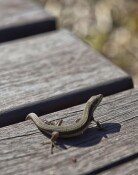Goguryeo memorial stone in Jian
Epitaph, or inscription in ancient memorial stones, is letters from ancient people addressed to us in modern world, transcending passage of time. Decoding epitaph is like listening to stories told by ancestors who did not leave records in books despite having characters. Telecommunicating with people from ancient times requires a process of buffering. Over passage of long time, epitaph gets weathered naturally and documents get damaged while taking a rubbing of stone inscription, with some characters getting blurred and indiscernible. This leaves room for distortion.
In the epitaph of Gwanggaeto Royal Tomb Stone erected in 414 by King Jangsu of the Goguryeo Kingdom, Japanese people created fabricated ancient inscription, called Namyeonseo, and inserted the so-called full text of rubbed text of the royal tomb stone, by changing three Chinese characters to indicate that Japan crossed the sea, defeated the Baekje Kingdom, and made the Shilla Kingdom to surrender, and colonized it. Japanese scholars still interpret the text to present such meaning even today, when the three characters are considered unidentifiable, and use the tombstone as the reason for alleged establishment of a Japanese governing office in ancient Korea.
Korean scholars see the subject for the word crossing in the sentence in question as Goguryeo, external to this sentence, instead of Japan, and interpret it as meaning When the year of Shinmyo reached Shilla (Korea), (Goguryeo) crossed the sea, defeated the Baekje Kingdom, rescued Shilla and colonized it. According to Korean scholars, Epitaph in Gwanggaeto Royal Tombstone is an outstanding writing, and if Japan crossed the sea in the year of Shinmyo, the sentence should have been written differently.
A new Goguryeo Memorial Stone was found last year at Jian in Jilin Province, China where Gwanggaeto Royal Tomb Stone is located. An official Chinese research report claims that it is the oldest Goguryeo memorial existing today, which was erected by King Gwanggaeto the Great. With some scholars refuting the claim saying that they deciphered the characters Jeongmyo suggesting that it was erected by King Jangsu in 427, scholars who wrote Chinas official research paper argue they did not see such characters. Instead, they claim that the Goguryeo Memorial Stone in Jian was erected due to the kingdoms close relationship with Chinese dynasty. Koreans, who already experienced attempted distortion of the epitaph on Gwanggaeto Royal Tome Stone by Japanese, naturally come to worry that China, which seeks to annex the history of Goguryeo as part of Chinese history, might distort Goguryeo Memorial Stone as well.
Editorial Writer Song Pyeong-in (pisong@donga.com)







